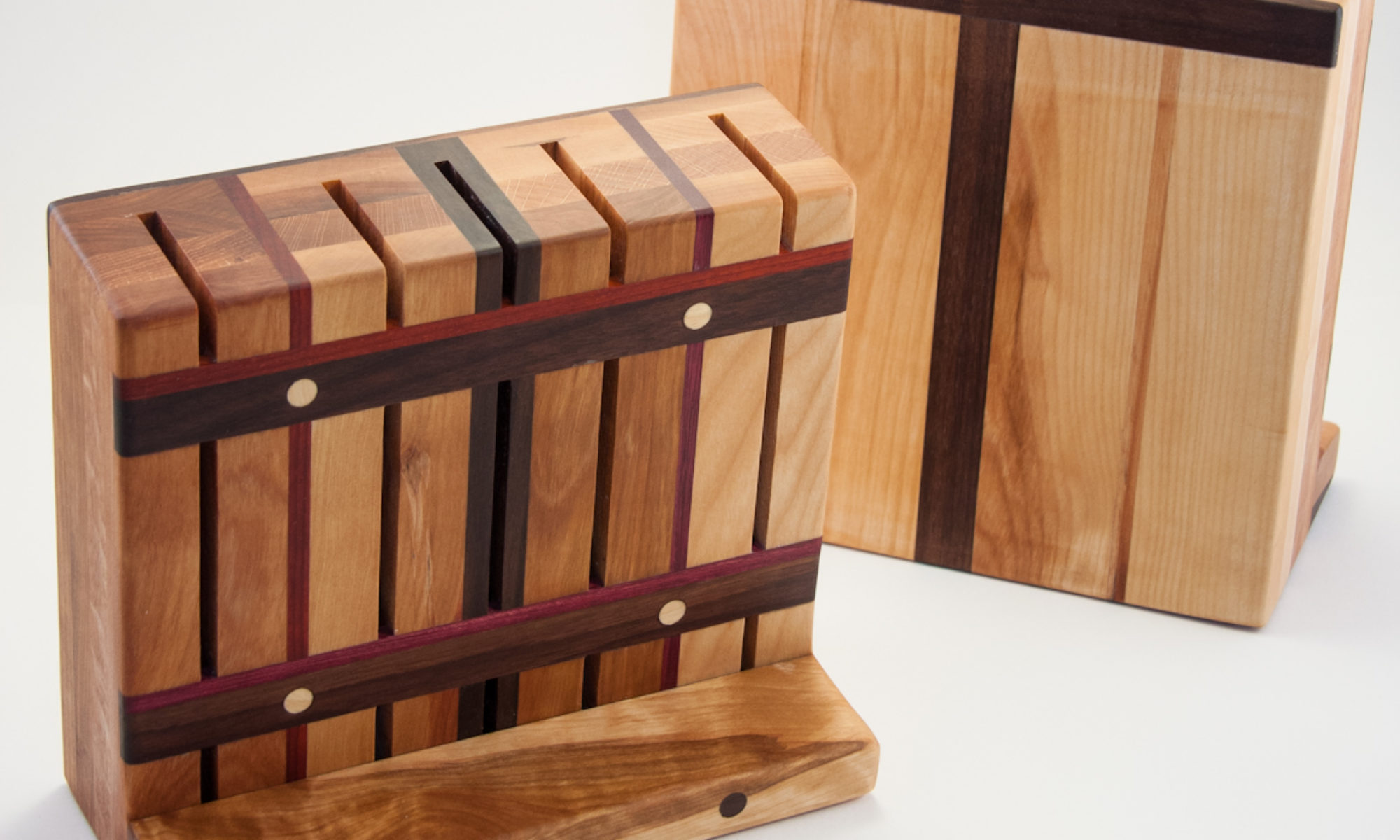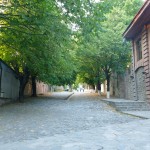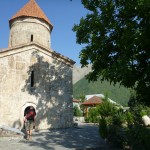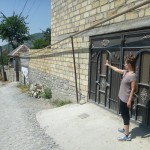Georgia is small and can be traversed from one end to the other in a couple of hours provided there are not too many trucks: on a single day of driving, we departed from Yerevan in Armenia and made it to Stepansmida (formerly known as Kazbegi) deep in northern Georgia. Lauded as one of the best destination for hiking, Stepansmida lies close to the Russian border high in the Caucasus mountains but only a 2h30 drive away from Tbilisi using the famous “Georgian military highway”. Our original goal was to spend two days there but due to unforeseen delays we only had one. Nonetheless, this would have provided us with half a day of hiking around as the rental car was not due until the middle of the afternoon.

The drive up was spectacular, even more so than earlier mountain scenery we had been exposed to. The weather was noticeably cooler, the peaks higher, the valleys deeper and the terrain more abrupt. On the way there, we picked up three Ukrainian hitchhikers which we managed to cram in the car along with their backpacks and a guitar. Our vehicle, already struggling, was taxed almost to its capacity but it was worth taking our time as the view was worth it. Having dropped our guests at their destination, we kept going until we encountered some weird Soviet era monument a bit before the Jvari pass. The structure was curious, but it was the scenery that caught our attention the most. I might be breaking graphic design rules here but I think it’s worth two large photos in a row.
We resumed the climb, crossed the Jvari pass and dived through a thick layer of clouds under which layed a large valley. However, something strange was profiling itself on the horizon. Trucks, and lots of them, stopped by the side of the road, with their drivers out just killing time with one another. What was wrong? Was the road damaged? The car we were following just kept going as if it was nothing important so we continued. For several kilometers and until we hit our destination we passed countless freight trucks stopped in the same fashion. Weird.
Having not booked any accommodation, we were turned down at the guesthouse we were hoping to sleep in. It was high season after all and that small town was one of the most popular destination in Georgia. After almost an hour of driving around to find beds, we finally had to settle for an expensive hotel that was offering us a (still expensive) discounted room. While eating diner that night, we asked the waiter about all the trucks lining the road. Turns out it was the lineup for the Russian customs. With the border in South-Ossetia and Abkhazia being closed to traffic coming from Georgia, that border crossing was the only one linking not only Georgia to Russia, but also Armenia and eastern Turkey.
The next day, I woke up to find out that my girlfriend had been sick all night from the a sketchy kebab we had eaten for lunch in Armenia. Some medication I gave her managed to improve her condition slightly, but she was in no shape to go on a hike. Anyway, the weather was foggy so in all cases our morning was ruined. The drive down from the mountains back to Tbilisi was not as spectacular so we went as fast as possible and managed to return the car on time but not without me informing the rental agency about all the issues the vehicle had. Independent rental agency tend to offer lower prices than franchises, but their cars are often in a rougher shape.
The first time we had been in Tbilisi, we had opted for a dorm in an hostel but given my girlfriend’s condition, we had booked a proper hotel. However, they had an unpleasant surprise waiting for us on arrival: the prices advertised on the booking site were inaccurate so they wanted to charge us way more. Wanting to explore other options, we walked around for a while trying to find an alternative but soon realized rooms in the old town were pricier than expected. In the end we ended up taking the room we had booked. The owner, feeling very sorry, excused herself many times and explained that the price discrepancy was due to the booking site (hostelworld.com) not working properly. Feeling she was the problem rather than the site, I offered her my help so while my girlfriend was catching a nap, I painstakingly rebuilt her hotel’s page on the booking site.
It was easy and contrary to her belief, everything was working as expected. Her issue was a case of failing to RTFM (read the f*cking manual). It took two hours but I was enjoying the experience of guiding here through the interface and giving her marketing advice for her establishment. Immensely grateful for my aid, she offered me coffee and snacks while I was working, charged me the price we had originally expected to pay for the room, promised me free beers that night and a ride to the airport the next day. I had wanted to use that time for work, but instead I got to discover how to set up and hostel on hostelworld.com. For the remainder of the day, not much happened, she went to bed early while I caught up on blogging and work, sipping on my well deserved free drinks.

 The following day, our last, she was doing much better so we checked out, left our bags at the hotel and proceeded to walk around Tbilisi. The Sameba Cathedral was our first objective. Built in 2004 to bolster faith and unity in a post-Soviet Georgia, nothing was spared in making it one of the most impressive structure in this corner of the world. It was immense, on many levels and took easily an hour to explore. The rest of the day was spent walking as far as we could and catching the metro back to the old town. We went through nice parts of town and some more popular ones, reminding us that Georgia is still a developing country and that our standard of living is the exception rather than the norm.
The following day, our last, she was doing much better so we checked out, left our bags at the hotel and proceeded to walk around Tbilisi. The Sameba Cathedral was our first objective. Built in 2004 to bolster faith and unity in a post-Soviet Georgia, nothing was spared in making it one of the most impressive structure in this corner of the world. It was immense, on many levels and took easily an hour to explore. The rest of the day was spent walking as far as we could and catching the metro back to the old town. We went through nice parts of town and some more popular ones, reminding us that Georgia is still a developing country and that our standard of living is the exception rather than the norm.

Our time in Georgia was almost over. We were leaving at 6h30 the next day and wanted to arrive at the airport around midnight to sleep there. There was however one more thing we needed to do: have a proper taste at Georgian wine and buy bottles to bring back home. That was what our last evening was devoted to. We visited a couple of shops which offered us cheap samples and poor service but settled on one that was a bit out of the way but about which I had a good feeling. I was right in my intuition, samples were plentiful, we got freebies and excellent service. Extremely satisfied with our experience and slightly inebriated, we decided we would give them the extra alcohol we had brought into the country but could not take back home. I had a bottle of Ouzo and some Quebec made Chic Choc spiced rum. I hope the gift was appreciated.
Tbilisi’s airport was small and crowded but we scored a pretty decent spot with an electrical outlet. She slept while I killed time on the computer until check-in started. After connections through Kiev and Amsterdam, we landed home at the end of the afternoon. It always takes a bit of time for the brain to switch out of traveling mode. As we were gazing in amazement at cars and houses, It felt like Montreal, a city extremely familiar to us, was new and exotic. That was obviously not the case, but it was certainly much different that what we had been used to seeing over the last few weeks. Azerbaijan, Georgia and Armenia had been feast for the eyes. Similar to each other in some aspects but very alike in others; it’s amazing how much diversity was packed in such a small area. The last weeks had been filled with amazing landscapes, amazing food and amazing encounters and our minds, not yet weened off the drug, was still craving for more even if a huge part of us, exhausted and in need of a rest, was happy to have arrived.
Our great disappointment was not having spent enough time in the region, but two weeks was all we could spare. In that time, we have barely brushed the surface of those three countries. We do not regret the ways we organized our time. It’s not like we can easily come back there; this may have been only chance to see that part of the world so doing a quick tour was in our opinion the best way to make the most of that trip. It’s hard for me to say what I enjoyed the most but I would most definitely put food and scenery at the top of the list so if I do come back, I’ll certainly orient my trip towards hiking expeditions, urban exploration of abandoned Soviet infrastructure and spend a bit of time in the wine making regions.
Oh yeah and if I do rent a vehicle, it’s going to be a 4×4.









































